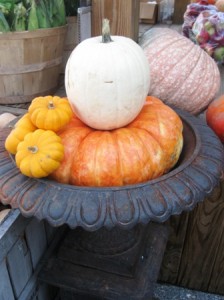An interesting article in the October Nashua Telegraph Feast section written by Liz and Haley Barbour along with Dan Harmon.
Fall is in full swing and pumpkins are ready to be picked at your local farm stands. The variety that trumps all is the Giant Pumpkin – colossal vegetables that are popular attractions at local fairs and fall festivals. At this year’s Hillsborough County Fair, the largest pumpkin weighed in at 1,173 pounds!
But, it’s more likely that you’re looking for a pumpkin to enter in a carving
contest or simply decorating your front porch, and you’re advised to act fast, as this year’s crop weathered some extreme conditions. The early summer drought slowed growth and pressured growers to irrigate their pumpkins. Then, Hurricane Irene dumped inches of rain on the fields, producing mold diseases that cause pumpkins to rot more quickly, pressuring local growers to pick early. So, once you find the pumpkin that is right for you, buy it before it’s too late!
How do you know which to buy? Whether you’ll be carving your pumpkin in the classic jack-o-lantern style, or using a fancy template to mark out an intricate design, be sure to give some thought to selecting the right pumpkin for the job.
Typically, the Magic Lantern, Wolfe, Gladiator, and Big Moose varieties are used for carving, but choose whatever inspires you. Many new varieties, such as “The Red Warty Thing” and the Cinderella, are attractive for both their decorative and cooking
qualities. The Lumina’s ghostly white exterior contrasts with the deep orange interior when carved and lit with a candle. And the small, softball-sized Ironsides is the perfect pumpkin for the kids to carry.
Choose a pumpkin that is firm, but whose shell is not too hard to cut with a serrated knife. Tap the pumpkin and listen for a hollow sound. A dense pumpkin is good, but too
dense and the walls will be too thick and block the candle light and any
carving details may be lost. Also, make sure that your pumpkin can balance on its base.
For information about where to go in the greater Nashua area for fresh pumpkins and
pumpkin picking, go to http://www.pumpkinpatchesandmore.org/NHpumpkins.php
and scroll down to “Hillsborough County.”
So what will you do with your pumpkin the day after Halloween? Considerbaking a pumpkin pie or yummy pumpkin soup, as pumpkins are extremely healthy and one of the most nutritious offerings of the fall season! The bright orange color of a
pumpkin’s skin and woody flesh is a dead giveaway to its heavy concentration of
beta-carotene, believed to reduce the risk of certain cancers and help fight heart disease. Pumpkin is also high in fiber, delivering three to five grams per serving.
For cooking, choose smaller to medium-sized pumpkins, as larger pumpkins tend to have a higher moisture content and mild flavor, and may disappoint. The Cinderella pumpkin, the Lumina pumpkin, or any sugar pumpkin will taste wonderful in a pie or pot of soup. Be sure that your pumpkin is free of blemishes, feels heavy for its size, and still has its stem attached. Store your cooking pumpkin in a cool, dry place or your refrigerator.
Pumpkin puree (not pie filling) has the highest concentration of fiber, as the puree is
thickened by cooking it down, thereby concentrating the nutritional content. To make puree for use in soups and baking, place your pumpkin whole on a pie plate and roast at 400˚ for 60-90 minutes or until a fork pierces the flesh easily. On smaller pumpkins, the skin is often very thin and can be peeled away from the flesh after roasting. Remove the seeds and place the cooked pumpkin into a food processor to puree. If the puree is too wet, strain with a fine mesh strainer or cheese cloth to remove extra water.
And, don’t forget about roasting your pumpkin seeds, as they are also full of
anti-oxidants, high in fiber, and protein and easy to prepare. Rinse the seeds and dry with paper towels. Season them with a little olive oil, kosher salt, and cook in a 250˚ oven for about 45 minutes, turning occasionally.
Then, boost the nutrition of any meal by adding pumpkin. Place a scoop of fresh pumpkin puree onto oatmeal and drizzle with maple syrup. Include pumpkin with any fruit
pie or any pureed soup for added flavor and health benefits. And, it’s easy to incorporate shelled pumpkin seeds purchased at the grocery store into your daily diet by substituting them for almonds or adding them to granola, salads, or cookies.
